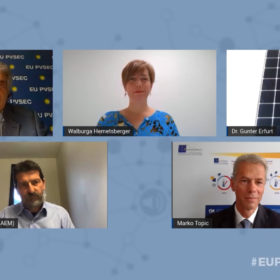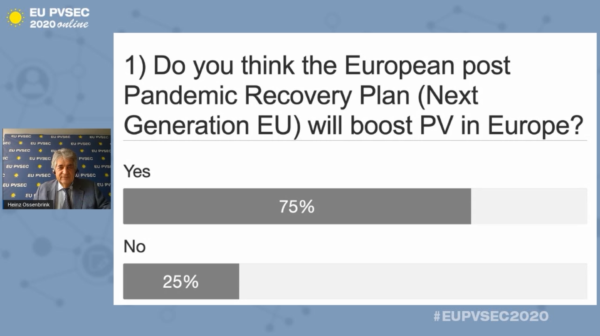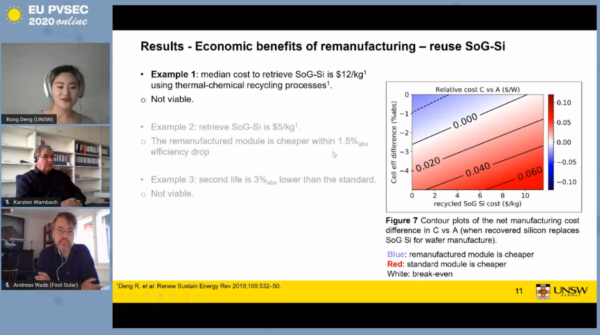
Spread across this week, the 37th EU PVSEC conference brought together companies and research institutes from Europe and further afield. This year’s presentations point to an industry standing at a crossroads. New challenges lie ahead, but there is plenty of optimism surrounding continuing growth and a more central role for PV in energy systems over the next decade. As the conference drew to a close on Friday, pv magazine offers five key takeaways.
This week, pv magazine was online for the first virtual edition, and the 37th overall, of the European PV Solar Energy Exhibition and Conference (EU PVSEC). Our key takeaways from this year’s event reflect growing optimism for solar to take up a central role in energy systems in Europe and beyond over the next decade, and an industry gearing up to tackle the challenges this will bring.
Europe wants manufacturing!
In the last few years, the poor health of Europe’s PV manufacturing landscape has been in evidence at EU PVSEC. The trade show segment of the event has got smaller each year, and achievements from industrial players have become increasingly absent from the presentations, though the continent’s established research institutes have been well placed to pick up the slack.
And while this is still broadly the case, with universities and research institutes representing the bulk of this year’s program, the conference revealed an air of cautious optimism regarding a manufacturing comeback over the coming decade.
Among the ‘main events’ was a panel held on Monday, in which the landscape for manufacturing in Europe was discussed in detail. And the key takeaway here was that support from the EU will be vital. With up to €750 billion potentially ‘on the table’ as part of the Union’s pandemic recovery facility, it will be up to the PV industry itself to ensure that a share of this is devoted to support for new manufacturing infrastructure.
In her closing remarks on Friday afternoon, EU PVSEC general chair Nicola Pearsall reiterated this call to action, stating: “When you go away from this conference, please engage with the European Green Deal or whatever the equivalent initiative is in your country, so as to make sure that PV is fully represented.”

Image: pv magazine/EU PVSEC
Management and monitoring
For solar to continue to make its way further into the energy mix, new strategies will be needed to balance and even redesign grids that were designed with very different energy flows and topologies in mind. Several sessions at this year’s conference revealed both the complexities and opportunities that this will bring.
It’s early days in addressing the challenge of grid integration, evidenced by the sheer number of different approaches on show. Wednesday afternoon saw noteworthy presentations on the potential for hydrogen here, as well as several ‘real-world’ examples from smaller systems, including an energy community project in France, that could provide important lessons for larger scale.
Another related development at this year’s conference was the demonstration of practical approaches to electric vehicles integrated with PV panels, which have long been seen as unrealistic. Encouraging work in this area was presented by Germany’s Fraunhofer ISE and the Netherlands’ TNO, among others. A valid question remains though, posed by solar industry veteran Pierre Verlinden after one presentation – will the automotive industry ever take an interest in such vehicles?
Perovskites are going industrial
EU PVSEC has long seen a wealth of presentations on the impressive achievements of perovskite solar cells and various tandem devices integrating them. The importance of this technology to the industry was underlined at the start of the conference, with Oxford University professor Henry Snaith awarded the Becquerel Prize for his pioneering work with perovskites.
Oxford PV, the spin-out company founded by Snaith, is targeting commercial production of perovskite-silicon tandem cells by the middle of next year. And among the many conference sessions devoted to perovskites, work on industrial processes and scaling up both tandem cells and standalone perovskite devices was front and center, including presentations from established factory equipment manufacturers looking to get in on the act.
Silicon is the next step for recycling

Image: pv magazine/ EU PVSEC
Environmental concerns are slowly pushing their way into mainstream thought throughout the PV industry. And different approaches to life cycle assessment, reducing land use, materials sourcing, and other sustainability concerns enjoyed a prominent position among this year’s presentations.
Recycling still presents one of the major challenges here. New regulations in Europe will soon require manufacturers to recycle 75%, and later 85%, of the volume of materials within a module, meaning current processes that extract the glass and steel or aluminum frame, leaving the rest for landfill, will no longer be enough. And the silicon itself is the next biggest chunk of the material by volume. Processes to purify silicon from older cells to the point where it can be put back into the top end of the PV supply chain were on show at EU PVSEC. These remain challenging economically, despite some interest from the industry.
Online events work
While the pv magazine team was initially a little disappointed to miss out on a trip to sunny Lisbon, I for one still feel like I have attended a real event. The virtual conference saw more than 850 presentations across 5 days, with 1,500 participants from 65 countries, and more than 3,000 viewers tuning in for the opening event which was streamed live on Youtube.
“We are proud of the whole PV community that we have managed to keep the program very much as it was originally intended,” technical program chair Robert Kenny told the audience on Friday. And, since Covid-19 related travel restrictions will surely be lifted at some point, the success of such online events surely raises questions regarding the environmental footprint of major ‘in person’ events requiring long-distance travel. For now though, the event organizers have announced plans for EU PVSEC 2021 to be held in Lisbon next September.
Lắp đặt điện mặt trời Khải Minh Tech
https://ift.tt/2X7bF6x
0906633505
info.khaiminhtech@gmail.com
80/39 Trần Quang Diệu, Phường 14, Quận 3
Lắp đặt điện mặt trời Khải Minh Tech
https://ift.tt/2ZH4TRU
Không có nhận xét nào:
Đăng nhận xét